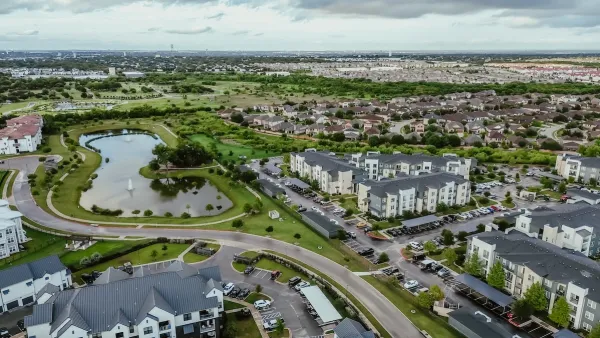To navigate the complexities of the current U.S. housing crisis, planners and decision makers must first understand how decades of past policy decisions led us here.

In the United States, the dramatic rise in income inequality and the pervasive need for housing have thrust housing policy into the spotlight. The crisis is now a common topic of conversation, from cafes to boardrooms. Governments at local, state, and federal levels are actively seeking solutions to address housing affordability and availability.
Several major forces have shaped housing policy in the US, including economic, social, and regulatory factors. Market dynamics (e.g. the underproduction of housing over many decades coupled with changing demographics and increased demand), construction costs, and investment trends all significantly impact housing availability and affordability. The financial crisis and subsequent recession over the past two decades exacerbated these issues, highlighting the fragility of the housing market and its broader economic implications.
Demographic changes, such as population growth and urbanization, also influence housing needs. Millennials and Generation Z, facing student debt and job market volatility, struggle to attain homeownership compared to previous generations. Local, state, and federal policies, including zoning laws and state and local codes, determine the framework within which housing is developed and maintained. The complexity and variation of these regulations can either facilitate or hinder housing development. But what does that mean for planners, and how can we tackle these challenges effectively?
Historical context of U.S. housing policy
To understand the root causes of today’s housing crisis, one must look at the historical evolution of U.S. housing policy because those past decisions have played a big role in shaping our current realities. In the early 20th century, zoning laws were introduced to regulate land use. While intended to organize urban growth, these laws often embedded exclusionary practices, segregating communities by race and class. Racially restrictive covenants and zoning codes created barriers that persist today, contributing to the current housing shortage and inequities. These practices systematically excluded minority groups from homeownership and investment opportunities, laying the groundwork for the economic disparities we see today.
Key federal actions in the 1960s and 1970s marked significant efforts to promote inclusive housing policies. The Civil Rights Act of 1968, which includes the Fair Housing Act, aimed to eliminate discrimination in housing. Despite these legislative victories, the implementation and enforcement of fair housing laws have been inconsistent. Urban renewal projects, while intended to revitalize cities, often resulted in the destruction of neighborhoods, disproportionately affecting minority communities. These projects displaced thousands, breaking up tight-knit communities and perpetuating cycles of poverty and disenfranchisement.
Contemporary housing plans are essential for identifying housing needs and implementing strategies to create and preserve affordable housing.
Effective housing plans consider comprehensive housing needs assessments, barrier analysis, and strategic implementation. Evaluating the current housing stock and projecting future needs allows planners to understand the scope of the problem. Identifying regulatory, social, and economic barriers helps in crafting targeted solutions. Strategic implementation involves utilizing a mix of regulatory and non-regulatory strategies to address housing issues.
Fundamentals of affordable housing
Affordable housing is a cornerstone of equitable communities. Defining affordable housing is essential for stable, diverse communities. It supports economic growth, health, and educational opportunities. Ensuring affordability, preserving deed restrictions, and expanding access to housing options are critical, though development often encounters challenges such as high costs, zoning restrictions, and community opposition. Addressing these issues is key to creating inclusive, resilient neighborhoods where all residents can succeed. Housing is considered affordable if a household spends no more than 30 percent of its gross household income on housing costs. However, rising construction costs, limited land availability, and regulatory hurdles make it difficult to create affordable housing. Preservation efforts are equally important, ensuring that existing affordable housing remains accessible through various means, such as rent control and subsidies.
Addressing housing affordability and availability requires a comprehensive approach, combining various strategies and policies.
Zoning amendments are crucial for updating codes to allow for more diverse housing types and higher density developments. Inclusionary housing policies can require or incentivize developers to include affordable units in new developments. Local funding sources, such as housing trust funds, provide financial support for affordable housing projects. First-time buyer programs offer financial assistance and education to help new homebuyers enter the market. Partnerships with private developers can increase the supply of affordable housing, and regional coalitions can advocate for and educate about housing needs across regions.
Zoning plays a crucial role in shaping housing opportunities. Equitable zoning practices aim to promote inclusion, prevent displacement, and foster engagement. Ensuring diverse housing options are available across all communities helps in creating balanced neighborhoods. Protecting existing residents from being pushed out because of rising costs or redevelopment is vital for maintaining community stability. Engaging community members in planning processes ensures their needs and voices are heard, leading to more effective and accepted policies.
Planning for housing
Effective housing plans share several components, including comprehensive assessments, clear goals and objectives, strategic actions, community engagement, and monitoring and evaluation. Thorough analysis of current housing stock and future needs is essential. Defined targets for housing production and preservation provide direction. Specific actions, such as regulatory changes and funding mechanisms, are necessary to achieve housing goals. Active involvement of residents and stakeholders in the planning process ensures broader support and better outcomes. Regular assessment of plan implementation and outcomes helps in making necessary adjustments.
Creating truly affordable housing is challenging because of high development costs, regulatory barriers, and market dynamics. Land, labor, and materials are expensive, driving up the cost of new construction. Innovations in construction technology and materials could potentially reduce these costs, but widespread adoption is slow. Zoning restrictions, permitting processes, and building codes can delay and add costs to housing projects. Streamlining these processes while maintaining safety and quality standards is essential. High demand in desirable areas drives up prices, making it difficult for lower-income households to find affordable options. Market-driven solutions alone often fail to address the needs of the most vulnerable populations.
Why is zoning hard to amend?
Amending zoning laws is often challenging because of community opposition, political hurdles, complex processes, and due to belief in past zoning decisions intended to protect or define the design of a neighborhood. Residents may resist changes that they perceive as threatening to property values or “neighborhood character.” This phenomenon, often referred to as NIMBYism (Not in My Backyard), can stall or derail proposed developments. Elected officials may be reluctant to support changes that could be unpopular with constituents. Balancing long-term community benefits with short-term political costs is a delicate act. Zoning amendments require navigating complex regulatory processes and often involve extensive studies and public hearings. These processes, while necessary for thorough evaluation, can be time-consuming and resource intensive.
Engaging communities in housing policy is crucial for equity. Ensuring all community members, especially those from marginalized groups, have a voice in the planning process is essential. Making planning processes transparent and accessible helps build trust and support. Collaboration with diverse stakeholders, including residents, developers, and advocacy groups, leads to more holistic solutions.
Applying lessons learned
Understanding U.S. housing policy is essential for comprehending the forces that have shaped today's housing crisis and for preventing future crises. By examining historical contexts, modern planning techniques, and effective strategies, planners can contribute to creating inclusive, vibrant communities where everyone has access to affordable, quality housing. Through comprehensive planning, strategic policy implementation, and community engagement, planners can help address the housing crisis and promote regional growth and prosperity.
By learning from the past and applying innovative solutions, we can address the housing challenges of today and ensure a more equitable and prosperous future for all. This holistic approach not only mitigates current issues but also sets the foundation for resilient communities capable of adapting to future housing needs.
Jennifer Raitt is executive director of the Northern Middlesex Council of Governments, a regional planning agency based in Lowell, Massachusetts and instructor of the recent Planetizen Course "US Housing Policy: What Every Planner Needs to Know," which delves into the historical and current facets of housing policy and provides planners with the necessary tools to tackle these challenges effectively.

National Parks Layoffs Will Cause Communities to Lose Billions
Thousands of essential park workers were laid off this week, just before the busy spring break season.

Retro-silient?: America’s First “Eco-burb,” The Woodlands Turns 50
A master-planned community north of Houston offers lessons on green infrastructure and resilient design, but falls short of its founder’s lofty affordability and walkability goals.

Delivering for America Plan Will Downgrade Mail Service in at Least 49.5 Percent of Zip Codes
Republican and Democrat lawmakers criticize the plan for its disproportionate negative impact on rural communities.

Test News Post 1
This is a summary

Test News Headline 46
Test for the image on the front page.

Balancing Bombs and Butterflies: How the National Guard Protects a Rare Species
The National Guard at Fort Indiantown Gap uses GIS technology and land management strategies to balance military training with conservation efforts, ensuring the survival of the rare eastern regal fritillary butterfly.
Urban Design for Planners 1: Software Tools
This six-course series explores essential urban design concepts using open source software and equips planners with the tools they need to participate fully in the urban design process.
Planning for Universal Design
Learn the tools for implementing Universal Design in planning regulations.
EMC Planning Group, Inc.
Planetizen
Planetizen
Mpact (formerly Rail~Volution)
Great Falls Development Authority, Inc.
HUDs Office of Policy Development and Research
NYU Wagner Graduate School of Public Service































